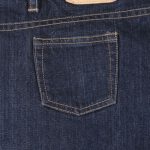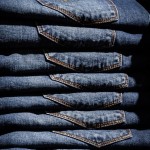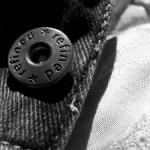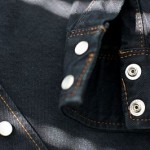When most people think of denim, they envision jeans. Jeans are characterized by a denim construction. You can find jeans in a variety of colors, sizes and styles, but they are all made of denim.
Not all denim is the same, however. There are many different types of denim, each of which features unique properties that distinguish it from the rest. What are the different types of denim exactly?
Distressed Denim
You’ve probably heard of distressed denim. As shown in the photo below, it’s characterized by an intentionally worn and degraded appearance. Manufacturers make distressed denim using chemical and/or physical treatments. Submerging denim in a bath of acid, for instance, is a chemical treatment used in the production of distressed denim. Exposing denim to pumice stones, on the other hand, is a physical treatment.
They involve different processes, but chemical treatments and physical treatments have the same effect: They wear down and degrade denim so that it looks older and more worn in. Distressed denim jeans have an aged, worn-in appearance that distinguishes them from other jeans made of non-distressed denim.
Raw Denim
The term “raw denim” refers to denim that hasn’t been washed or otherwise exposed to water during production. Also known as dry denim, it’s made using a loom — just like most other types of denim. Raw denim, though, isn’t washed or exposed to water during production. After coming off the loom, it’s used to make jeans, denim jackets, denim skirts and other garments and accessories.
You may discover that raw denim has a darker color than other types of denim. It’s still dyed during production, but raw denim isn’t washed. Therefore, it retains more of its dye. If you’re looking to buy a pair of Indigo or other dark-colored jeans, you may want to opt for raw denim. It will result in a darker, stronger color than that of other types of denim.
Washed Denim
In addition to raw denim, there’s washed denim. Washed denim is essentially the opposite of raw denim. While raw denim isn’t washed during production, washed denim is washed during production.
Most jeans and other denim garments can be classified as raw or washed denim depending on whether they were washed during production. Washed denim, as the name suggests, is washed during production. Manufacturers create the denim using a loom, and after dyeing it, they wash it in a bath of water.
Washed denim has a lighter tone than its raw counterpart. Some people prefer the lighter tone of washed denim, as it’s better protected against bleeding colors and fading than raw denim. Another benefit of washed denim is protection from shrinkage. You can clean garments made of washed denim in the washing machine without fear of them shrinking to a smaller size. Since they’ve already been washed during production, they are better protected from shrinkage.

Lightweight Denim
Lightweight denim is exactly what it sounds like: denim that weighs less than other types of denim. Denim is made of cotton. Cotton threads are woven together in a particular pattern to create denim. The total weight of the finished denim will determine whether it’s lightweight denim.
Lightweight denim weighs less than other types of denim. It’s still made of cotton, and it still features the same weaving pattern. Lightweight denim is simply thinner and, thus, lighter than other types of denim.
Heavyweight Denim
Some denim is designed specifically to be lightweight, there’s other denim is designed to be heavyweight. Heavyweight denim weighs more than lightweight denim. When comparing lightweight and heavyweight denim, you may notice that the latter is thicker.
The thickness of denim will affect its weight. Heavyweight denim is typically thicker than its lightweight counterpart, resulting in a heavier weight. And with its heavier weight, heavyweight denim is warmer. It offers better insulation, making heavyweight denim jeans and garments ideal for the cooler months of the year.
Selvedge Denim
There’s also selvedge denim. Selvedge denim is a type of premium, high-end denim that’s made on an old-style shuttle loom. All types of denim are made of a loom. While most types are made on a modern projectile loom, though, selvedge denim is made on an old-style shuttle loom.
Using an old-style shuttle loom, manufacturers will pass the cross thread back and forth to create selvedge denim. The end result is clean, finished edges, which is in stark contrast to other types of denim. Denim that’s made on a modern projectile loom doesn’t feature these same clean and finished edges. Instead, the edges are frayed.
There’s nothing wrong with choosing denim made on a modern projectile loom. But if you’re looking for clean and finished edges, you should consider choosing selvedge denim.
Crosshatch Denim
When researching the different types of denim, you may come across crosshatch. Crosshatch denim is a type of denim that features an uneven weaving pattern. Like other types of denim, it consists of warp threads and weft threads. The difference is that crosshatch denim is intentionally woven unevenly. Crosshatch denim is typically used to make jeans, but it’s not as common as other types of denim.
Stretch Denim
We can’t talk about the different types of denim without mentioning stretch denim. You’ve probably heard of stretch denim. It’s commonly used in the production of jeans, known as stretch jeans, and even jeggings. What is stretch denim exactly?
Stretch denim is a type of denim that features a blended construction consisting of cotton and an elastic material. It’s naturally stretchy, which is attributed to its use of an elastic material. Other types of denim are made entirely of cotton. Stretch denim, in comparison, is made of both cotton and an elastic material. The elastic material used in its construction makes it stretchy. You can pull, bend and stretch it without damaging it. Stretch denim will simply return to its original shape.











